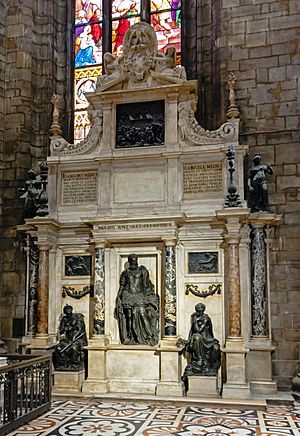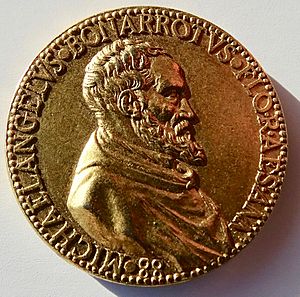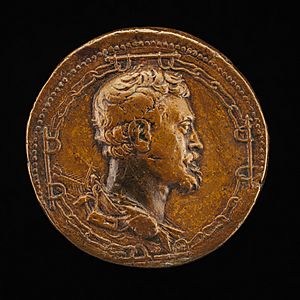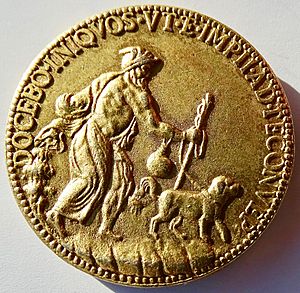Leone Leoni facts for kids
For the early 17th-century composer, see Leone Leoni (composer). Leone Leoni (born around 1509 – died 22 July 1590) was a famous Italian sculptor. He was known all over Europe and traveled a lot. He visited countries like Germany, France, Spain, and the Netherlands.
Leoni is considered one of the best medallists of his time. A medallist is an artist who makes medals, which are like small sculptures. He became famous for the artworks he created for the powerful Habsburg rulers. These included Charles V, Holy Roman Emperor and Philip II of Spain.
He mostly worked with bronze. But he also used marble and alabaster. He even carved gemstones and designed coins. Leoni mainly created portraits of people. The Spanish and Austrian Habsburg families often asked him to make their portraits.
Leone Leoni's Life Story
Leone Leoni's family came from Arezzo, Italy. But he was probably born near Lake Como. He learned his skills from a medallist or a goldsmith. This is what Vasari, a famous writer, said about him.
His first records show him in Venice after 1533. He lived there with his wife and young son. He was helped by Pietro Aretino, who was also from Arezzo. Aretino introduced him to the artist Titian.
Leoni became the designer for the Papal mint in Ferrara from 1538 to 1540. The Papal mint made coins for the Pope. However, he had to leave after someone accused him of making counterfeit money. He was even sentenced to a harsh punishment. But powerful friends helped him, and he was freed after a year. As a thank you, Leoni made several artworks for Andrea Doria, who helped him.
After being freed, Leoni moved to Milan. He became the master of the mint there in 1542. He earned a good salary and was given a house. Leoni rebuilt his house in Milan between 1565 and 1567. It was called the Casa degli Omenoni. This means "House of the Big Men." It had large, strong figures carved into its walls. These figures were unusual for Milan at that time. They showed how successful Leoni had become.
He had a large collection of ancient sculptures. He even had a big stucco copy of the famous equestrian Marcus Aurelius statue in his courtyard. His early helper in Milan was the Imperial Governor, Ferrante Gonzaga. Leoni stayed in Milan for the rest of his life. He often said he needed to be there to get the right materials for his art.
Leoni first became known for his portrait medals. Later, he received big commissions from Charles V, Holy Roman Emperor. Charles V's image is known today through paintings by Titian and sculptures by Leoni. Leoni visited Charles V in Brussels in 1549. He made portraits of the Emperor from real life. Charles V enjoyed Leoni's company and watched him work for hours. Charles V even made Leoni a knight in 1549.

For the cathedral of Milan, Leoni created five bronze figures. These were for the monument of Gian Giacomo Medici. Medici was a military leader and the brother of Pope Pius IV. The marble design around the figures was thought to be from a drawing by Michelangelo.
Cardinal Granvelle also asked Leoni to create art. Granvelle was a very important minister for the Habsburgs. Leoni made life-sized half-figures of Charles V, Philip II, and the Cardinal. These were set in fancy oval frames. Granvelle and Leoni often wrote to each other about these projects.
Leoni's work for the Spanish royal family was a continuation of his work for the Habsburgs. When he returned from Spain, he brought back a lot of money. He created a new style for portrait busts. These busts would be placed on a stand and showed the person from the chest or stomach up. He also made life-sized bronze statues. These were not for tombs, which was new for the time.
Leoni's son, Pompeo Leoni (born around 1533 – died 1608), helped him. Pompeo continued his father's bronze-casting workshop after Leone died. Pompeo also collected many drawings and notes by Leonardo da Vinci. These are now known as the Codex Atlanticus.
Leone Leoni's name remained famous in 16th-century sculpture. Many artworks were later thought to be his.
Famous Artworks by Leone Leoni

- Medals: He made medals of important people like Charles V, Ferdinand I, Philip II, Giorgio Vasari, Michelangelo Buonarroti, Andrea Doria, and Ippolita Gonzaga.
- Charles V Dominating Fury: A sculpture from 1550-53, now in the Museo del Prado.
- Standing portrait of Isabella of Portugal: Also in the Museo del Prado.
- Bust of Giacomo Maria Stampa: A bronze bust from 1553, at the Walters Art Museum.
- Portrait of Philip II: Made in 1554, this portrait was shown in Milan before going to Spain.
- Bust of Alfonso d'Avalos: A bronze bust at the Morgan Library in New York.
- Gian Giacomo Medici Monument: Five bronze figures for the monument in Milan Cathedral, made between 1560–63. It includes a portrait of Gian Giacomo with figures representing Peace and Martial Virtue. Above them are Providence and Fame.
- Triumph of Ferrante Gonzaga over Envy: A sculpture from 1564, found in Guastalla. It celebrates Ferrante's time as governor of Milan.
- Kneeling figures: Sculptures of Charles V, Philip II, and their families, made for the church at the Escorial.
- Bust of Charles V: A bronze bust in the Museo del Prado.
- Bust of Philip II: An alabaster bust in the Museo del Prado, and another marble one in the Metropolitan Museum.
- Bust of Charles Emmanuel I, Duke of Savoy: A bronze bust of him as a boy, from 1572, at the Philadelphia Museum of Art.
- Half-figures in ovals: Sculptures of Charles V, Philip II, and Cardinal Granvelle, mentioned by Vasari.
- Carved gemstone miniatures: Tiny portraits of Charles V and Philip II (a double portrait), and Isabella of Portugal. Some are at the Metropolitan Museum, including a gold pendant with jewels and enamel.
- Michelangelo's 88th birthday medal: An undated medal made around 1563.
See also
 In Spanish: Leone Leoni para niños
In Spanish: Leone Leoni para niños






